Simulation on Unsteady Crosswind Forces of a Moving Train in a Three-Dimensional Stochastic Wind Field
Abstract
:1. Introduction
2. CFD Numerical Model
2.1. Governing Equations and Turbulence Model
2.2. Model Descriptions
2.3. Overset Mesh
2.4. CFD Validation
3. Prediction Model of Aerodynamic Coefficients
3.1. Flow Characteristics
3.2. Aerodynamic Coefficients
4. Wind Turbulence with Respect to a Moving Train
5. Unsteady Aerodynamic Forces Prediction with a Complete Turbulence
5.1. Prediction Model
5.2. Case Study
6. Conclusions and Further Works
- (1)
- The flow pattern of a moving train exposed to a crosswind is characterized by three-dimensional structures on account of the aerodynamic coupling effect of the train-induced wind and crosswind, and it is mainly determined by the resultant wind speed VR and yaw angle β, related to the train speed V and wind speed U with a flow angle of α.
- (2)
- A generalized sine expression can be used to predict the aerodynamic coefficient of a moving train varying with the resultant wind yaw angle, and based on wind tunnel test data, it is proved that the prediction formula is possible to be applied to most types of trains.
- (3)
- The quasi-steady and weighting function methods are developed through a mathematical process to calculate unsteady aerodynamic forces of a moving vehicle in a three-dimensional stochastic wind field, which shows good agreements with previous models. Moreover, the filtering and time lag effects are found in the weighting function approach.
- (4)
- When the complete wind turbulence is considered, greater force fluctuation and peak can be found, and also, variations in the wind direction are crucial to unsteady aerodynamic forces of moving trains, which can lead to maximum mean force at approximately 90° wind direction. However, when the flow direction of crosswind deviates from 90°, consideration of only a portion of the turbulence components may underestimate the dynamic response of trains.
Author Contributions
Funding
Institutional Review Board Statement
Informed Consent Statement
Data Availability Statement
Conflicts of Interest
References
- Andersson, E.; Häggström, J.; Sima, M.; Stichel, S. Assessment of train-overturning risk due to strong cross-winds. Proc. Inst. Mech. Eng. Part F J. Rail Rapid Transit 2004, 218, 213–223. [Google Scholar] [CrossRef]
- Baker, C.; Cheli, F.; Orellano, A.; Paradot, N.; Proppe, C.; Rocchi, D. Cross-wind effects on road and rail vehicles. Veh. Syst. Dyn. 2009, 47, 983–1022. [Google Scholar] [CrossRef]
- Li, X.; Xiao, J.; Liu, D.; Wang, M.; Zhang, D. An analytical model for the fluctuating wind velocity spectra of a moving vehicle. J. Wind Eng. Ind. Aerodyn. 2017, 164, 34–43. [Google Scholar] [CrossRef]
- Xu, Y.; Ding, Q. Interaction of railway vehicles with track in cross-winds. J. Fluids Struct. 2006, 22, 295–314. [Google Scholar] [CrossRef]
- Zhai, W.; Yang, J.; Li, Z.; Han, H. Dynamics of high-speed train in crosswinds based on an air-train-track interaction model. Wind Struct. 2015, 20, 143–168. [Google Scholar] [CrossRef]
- Baker, C. Risk analysis of pedestrian and vehicle safety in windy environments. J. Wind Eng. Ind. Aerodyn. 2015, 147, 283–290. [Google Scholar] [CrossRef]
- He, X.; Shi, K.; Wu, T. An efficient analysis framework for high-speed train-bridge coupled vibration under non-stationary winds. Struct. Infrastruct. Eng. 2020, 16, 1326–1346. [Google Scholar] [CrossRef]
- Montenegro, P.; Barbosa, D.; Carvalho, H.; Calçada, R. Dynamic effects on a train-bridge system caused by stochastically generated turbulent wind fields. Eng. Struct. 2020, 211, 110430. [Google Scholar] [CrossRef]
- Neto, J.; Montenegro, P.; Vale, C.; Calçada, R. Evaluation of the train running safety under crosswinds-a numerical study on the influence of the wind speed and orientation considering the normative Chinese Hat Model. Int. J. Rail Transp. 2021, 9, 204–231. [Google Scholar] [CrossRef]
- Yao, Z.; Zhang, N. Overturning assessment of railway vehicles under cross winds. Wind Struct. 2021, 33, 1–11. [Google Scholar] [CrossRef]
- Han, Y.; Zhang, X.; Wang, L.; Zhu, Z.; Cai, C.S.; He, X. Running Safety Assessment of a Train Traversing a Long-Span Bridge Under Sudden Changes in Wind Loads Owing to Damaged Wind Barriers. Int. J. Struct. Stab. Dyn. 2022, 22, 2241010. [Google Scholar] [CrossRef]
- Wang, M.; Li, X.; Chen, X. A simplified analysis framework for assessing overturning risk of high-speed trains over bridges under crosswind. Veh. Syst. Dyn. 2022, 60, 1037–1047. [Google Scholar] [CrossRef]
- Baker, C.; Jones, J.; Lopez-Calleja, F.; Munday, J. Measurements of the cross wind forces on trains. J. Wind Eng. Ind. Aerodyn. 2004, 92, 547–563. [Google Scholar] [CrossRef]
- Cheli, F.; Ripamonti, F.; Rocchi, D.; Tomasini, G. Aerodynamic behaviour investigation of the new EMUV250 train to cross wind. J. Wind Eng. Ind. Aerodyn. 2010, 98, 189–201. [Google Scholar] [CrossRef]
- Yao, Z.; Zhang, N.; Chen, X.; Zhang, C.; Xia, H.; Li, X. The effect of moving train on the aerodynamic performances of train-bridge system with a crosswind. Eng. Appl. Comput. Fluid Mech. 2020, 14, 222–235. [Google Scholar] [CrossRef]
- Li, X.; Tan, Y.; Qiu, X.; Gong, Z.; Wang, M. Wind tunnel measurement of aerodynamic characteristics of trains passing each other on a simply supported box girder bridge. Railw. Eng. Sci. 2021, 29, 152–162. [Google Scholar] [CrossRef]
- Wu, J.; Li, X.; Cai, C.S.; Liu, D. Aerodynamic characteristics of a high-speed train crossing the wake of a bridge tower from moving model experiments. Railw. Eng. Sci. 2022, 30, 221–241. [Google Scholar] [CrossRef]
- Li, Y.; Hu, P.; Xu, Y.; Zhang, M.; Liao, H. Wind loads on a moving vehicle-bridge deck system by wind-tunnel model test. Wind Struct. 2014, 19, 145–167. [Google Scholar] [CrossRef]
- Xiang, H.; Li, Y.; Chen, S.; Hou, G. Wind loads of moving vehicle on bridge with solid wind barrier. Eng. Struct. 2018, 156, 188–196. [Google Scholar] [CrossRef]
- Li, X.; Wang, M.; Xiao, J.; Zou, Q.; Liu, D. Experimental study on aerodynamic characteristics of high-speed train on a truss bridge: A moving model test. J. Wind Eng. Ind. Aerodyn. 2018, 179, 26–38. [Google Scholar] [CrossRef]
- He, X.; Zou, S. Crosswind effects on a train-bridge system: Wind tunnel tests with a moving vehicle. Struct. Infrastruct. Eng. 2021, 1–13. [Google Scholar] [CrossRef]
- Hu, Y.; Xu, F.; Gao, Z. A Comparative Study of the Simulation Accuracy and Efficiency for the Urban Wind Environment Based on CFD Plug-Ins Integrated into Architectural Design Platforms. Buildings 2022, 12, 1487. [Google Scholar] [CrossRef]
- Song, J.L.; Li, J.W.; Xu, R.Z.; Flay, R.G. Field measurements and CFD simulations of wind characteristics at the Yellow River bridge site in a converging-channel terrain. Eng. Appl. Comput. Fluid Mech. 2022, 16, 58–72. [Google Scholar] [CrossRef]
- Rizzo, F.; D’Alessandro, V.; Montelpare, S.; Giammichele, L. Computational study of a bluff body aerodynamics: Impact of the laminar-to-turbulent transition modelling. Int. J. Mech. Sci. 2020, 178, 105620. [Google Scholar] [CrossRef]
- Sun, Z.; Yao, S.; Wei, L.; Yao, Y.; Yang, G. Numerical investigation on the influence of the streamlined structures of the high-speed train’s nose on aerodynamic performances. Appl. Sci. 2021, 11, 784. [Google Scholar] [CrossRef]
- Yan, J.; Chen, T.; Deng, E.; Yang, W.; Cheng, S.; Zhang, B. Aerodynamic Response and Running Posture Analysis When the Train Passes a Crosswind Region on a Bridge. Appl. Sci. 2021, 11, 4126. [Google Scholar] [CrossRef]
- Zou, S.; He, X.; Wang, H. Numerical investigation on the crosswind effects on a train running on a bridge. Eng. Appl. Comput. Fluid Mech. 2020, 14, 1458–1471. [Google Scholar] [CrossRef]
- Chen, Z.W.; Rui, E.Z.; Liu, T.H.; Ni, Y.Q.; Huo, X.S.; Xia, Y.T.; Li, W.H.; Guo, Z.J.; Zhou, L. Unsteady Aerodynamic Characteristics of a High-Speed Train Induced by the Sudden Change of Windbreak Wall Structure: A Case Study of the Xinjiang Railway. Appl. Sci. 2022, 12, 7217. [Google Scholar] [CrossRef]
- Wang, B.; Xu, Y.; Zhu, L.; Li, Y. Crosswind effect studies on road vehicle passing by bridge tower using computational fluid dynamics. Eng. Appl. Comput. Fluid Mech. 2014, 8, 330–344. [Google Scholar] [CrossRef]
- Wang, M.; Li, X.; Xiao, J.; Zou, Q.; Sha, H. An experimental analysis of the aerodynamic characteristics of a high-speed train on a bridge under crosswinds. J. Wind Eng. Ind. Aerodyn. 2018, 177, 92–100. [Google Scholar] [CrossRef]
- Wang, Y.; Xia, H.; Guo, W.; Zhang, N.; Wang, S. Numerical analysis of wind field induced by moving train on HSR bridge subjected to crosswind. Wind Struct. 2018, 27, 29–40. [Google Scholar] [CrossRef]
- Chiu, T.; Squire, L. An experimental study of the flow over a train in a crosswind at large yaw angles up to 90. J. Wind Eng. Ind. Aerodyn. 1992, 45, 47–74. [Google Scholar] [CrossRef]
- Baker, C. Ground vehicles in high cross winds part I: Steady aerodynamic forces. J. Fluids Struct. 1991, 5, 69–90. [Google Scholar] [CrossRef]
- Baker, C. The simulation of unsteady aerodynamic cross wind forces on trains. J. Wind Eng. Ind. Aerodyn. 2010, 98, 88–99. [Google Scholar] [CrossRef]
- Cooper, R. Atmospheric turbulence with respect to moving ground vehicles. J. Wind Eng. Ind. Aerodyn. 1984, 17, 215–238. [Google Scholar] [CrossRef]
- Yu, M.; Liu, J.; Liu, D.; Chen, H.; Zhang, J. Investigation of aerodynamic effects on the high-speed train exposed to longitudinal and lateral wind velocities. J. Fluids Struct. 2016, 61, 347–361. [Google Scholar] [CrossRef]
- Wu, M.; Li, Y.; Chen, X.; Hu, P. Wind spectrum and correlation characteristics relative to vehicles moving through cross wind field. J. Wind Eng. Ind. Aerodyn. 2014, 133, 92–100. [Google Scholar] [CrossRef]
- Yan, N.; Chen, X.; Li, Y. Assessment of overturning risk of high-speed trains in strong crosswinds using spectral analysis approach. J. Wind Eng. Ind. Aerodyn. 2018, 174, 103–118. [Google Scholar] [CrossRef]
- Hu, P.; Han, Y.; Cai, C.; Cheng, W.; Lin, W. New analytical models for power spectral density and coherence function of wind turbulence relative to a moving vehicle under crosswinds. J. Wind Eng. Ind. Aerodyn. 2019, 188, 384–396. [Google Scholar] [CrossRef]
- Li, Y.; Qiang, S.; Liao, H.; Xu, Y. Dynamics of wind-rail vehicle-bridge systems. J. Wind Eng. Ind. Aerodyn. 2005, 93, 483–507. [Google Scholar] [CrossRef]
- Cheli, F.; Corradi, R.; Tomasini, G. Crosswind action on rail vehicles: A methodology for the estimation of the characteristic wind curves. J. Wind Eng. Ind. Aerodyn. 2012, 104–106, 248–255. [Google Scholar] [CrossRef]
- Sha, H. Aerodynamic Characteristics of Simply Supported Beam High Speed Train System under Crosswinds. Master’s Thesis, Southwest Jiaotong University, Chendu, China, 2019. [Google Scholar]
- Copley, J. The three-dimensional flow around railway trains. J. Wind Eng. Ind. Aerodyn. 1987, 26, 21–52. [Google Scholar] [CrossRef]
- EN 14067-6; Railway Applications Aerodynamics Part 6: Requirements and Test Procedures for Cross Wind Assessment. CEN: Brussels, Belgium, 2018.
- Cao, Y.; Xiang, H.; Zhou, Y. Simulation of stochastic wind velocity field on long-span bridges. J. Eng. Mech. 2000, 126, 1–6. [Google Scholar] [CrossRef]
- Cai, C.; Hu, J.; Chen, S.; Han, Y.; Zhang, W.; Kong, X. A coupled wind-vehicle-bridge system and its applications: A review. Wind Struct. 2015, 20, 117–142. [Google Scholar] [CrossRef] [Green Version]
- Olmos, J.M.; Astiz, M.A. Improvement of the lateral dynamic response of a high pier viaduct under turbulent wind during the high-speed train travel. Eng. Struct. 2018, 165, 368–385. [Google Scholar] [CrossRef]
- Sterling, M.; Baker, C.; Bouferrouk, A.; ONeil, H.; Wood, S.; Crosbie, E. An investigation of the aerodynamic admittances and aerodynamic weighting functions of trains. J. Wind Eng. Ind. Aerodyn. 2009, 97, 512–522. [Google Scholar] [CrossRef] [Green Version]
- Tomasini, G.; Cheli, F. Admittance function to evaluate aerodynamic loads on vehicles: Experimental data and numerical model. J. Fluids Struct. 2013, 38, 92–106. [Google Scholar] [CrossRef]
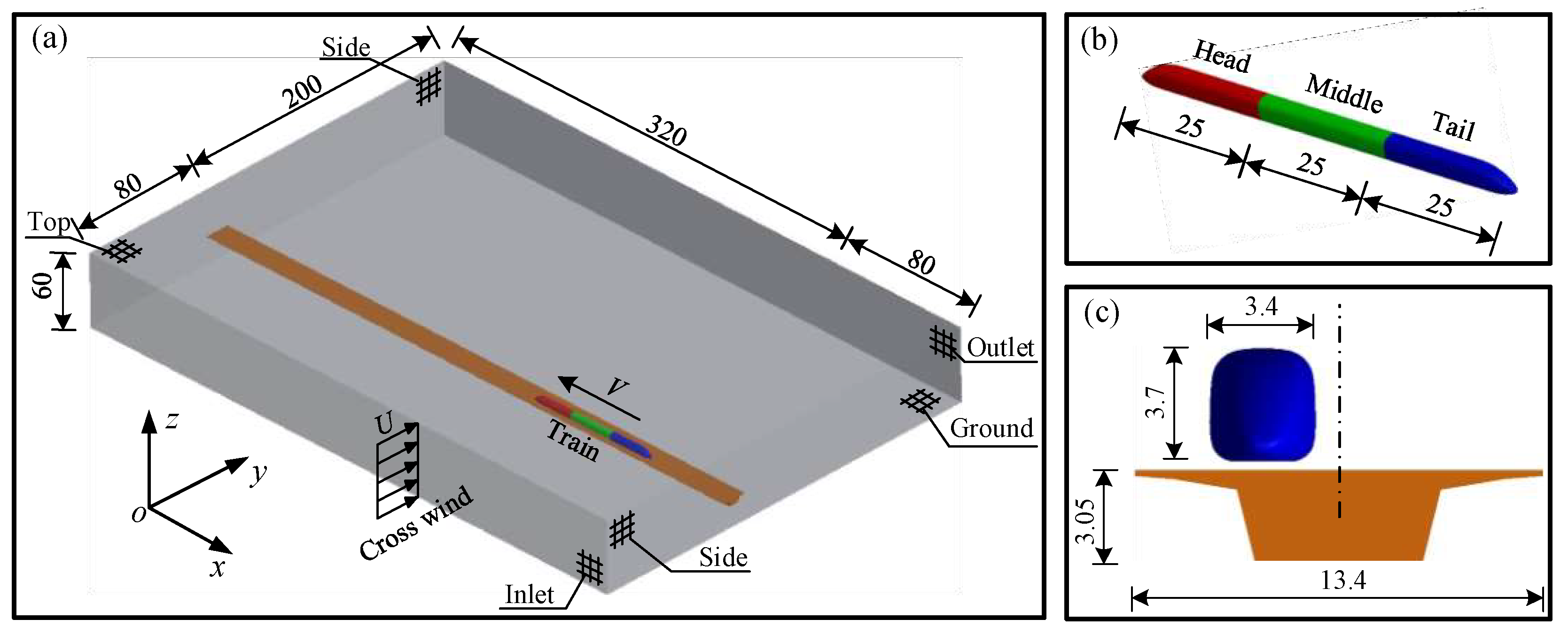
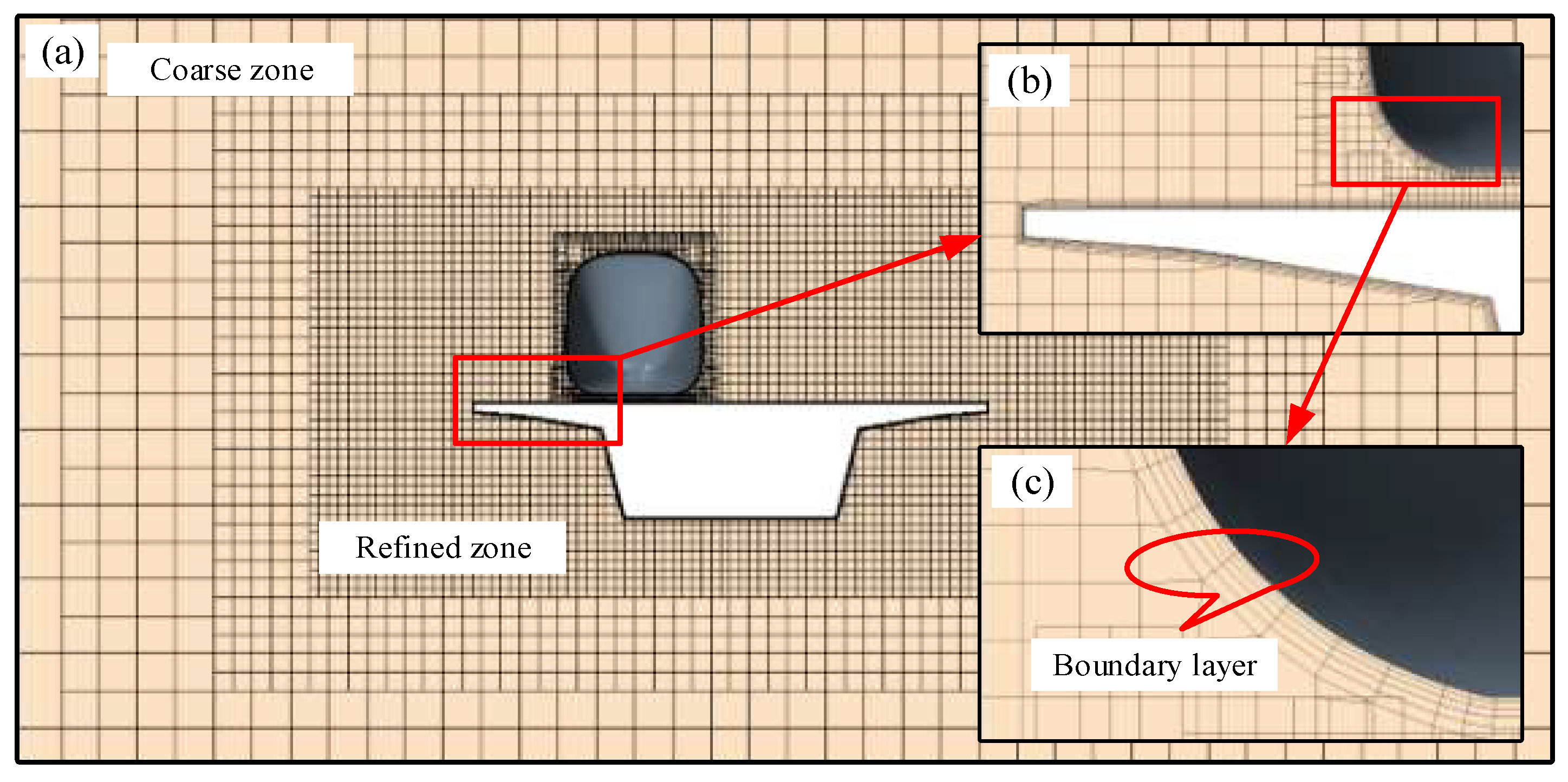
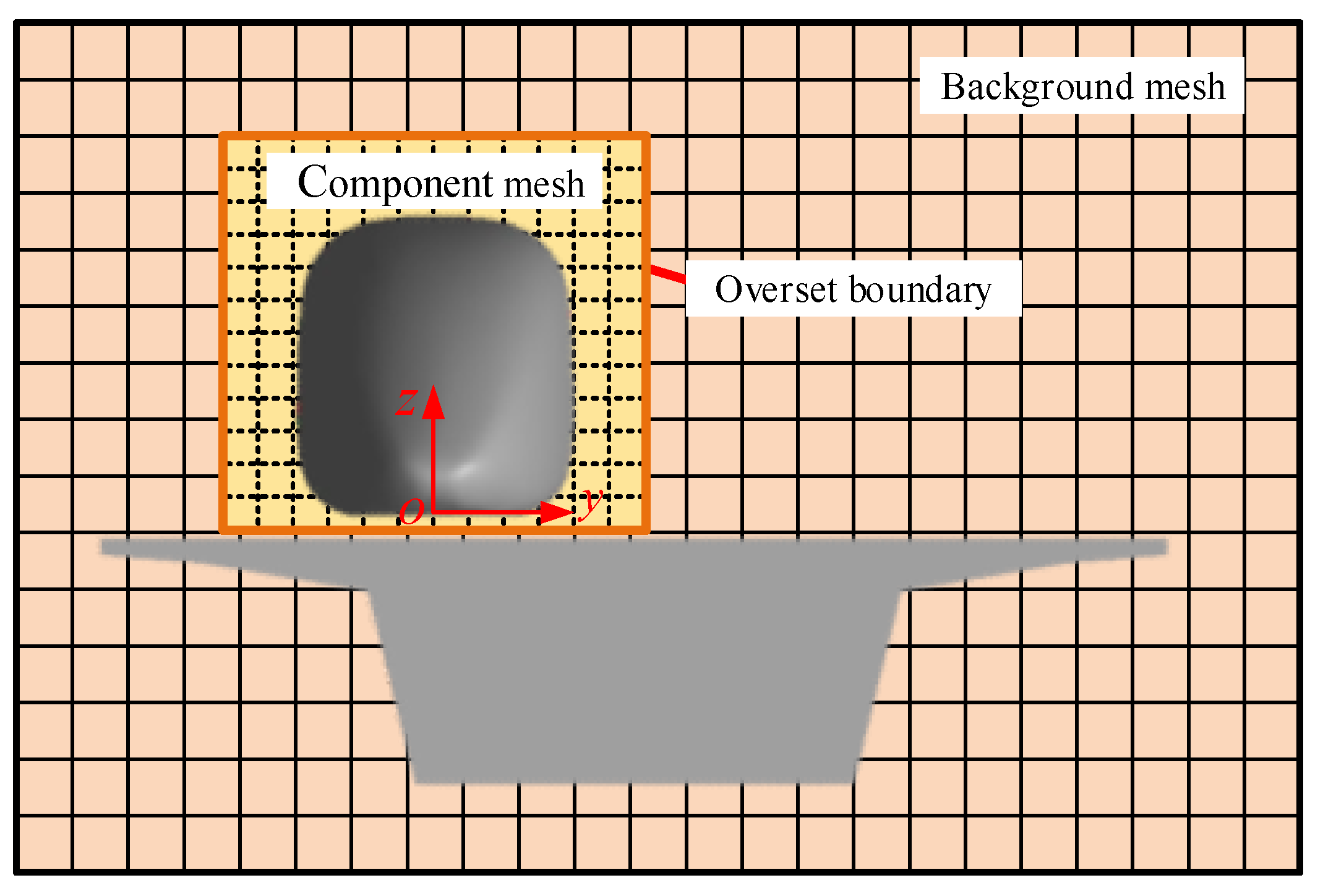
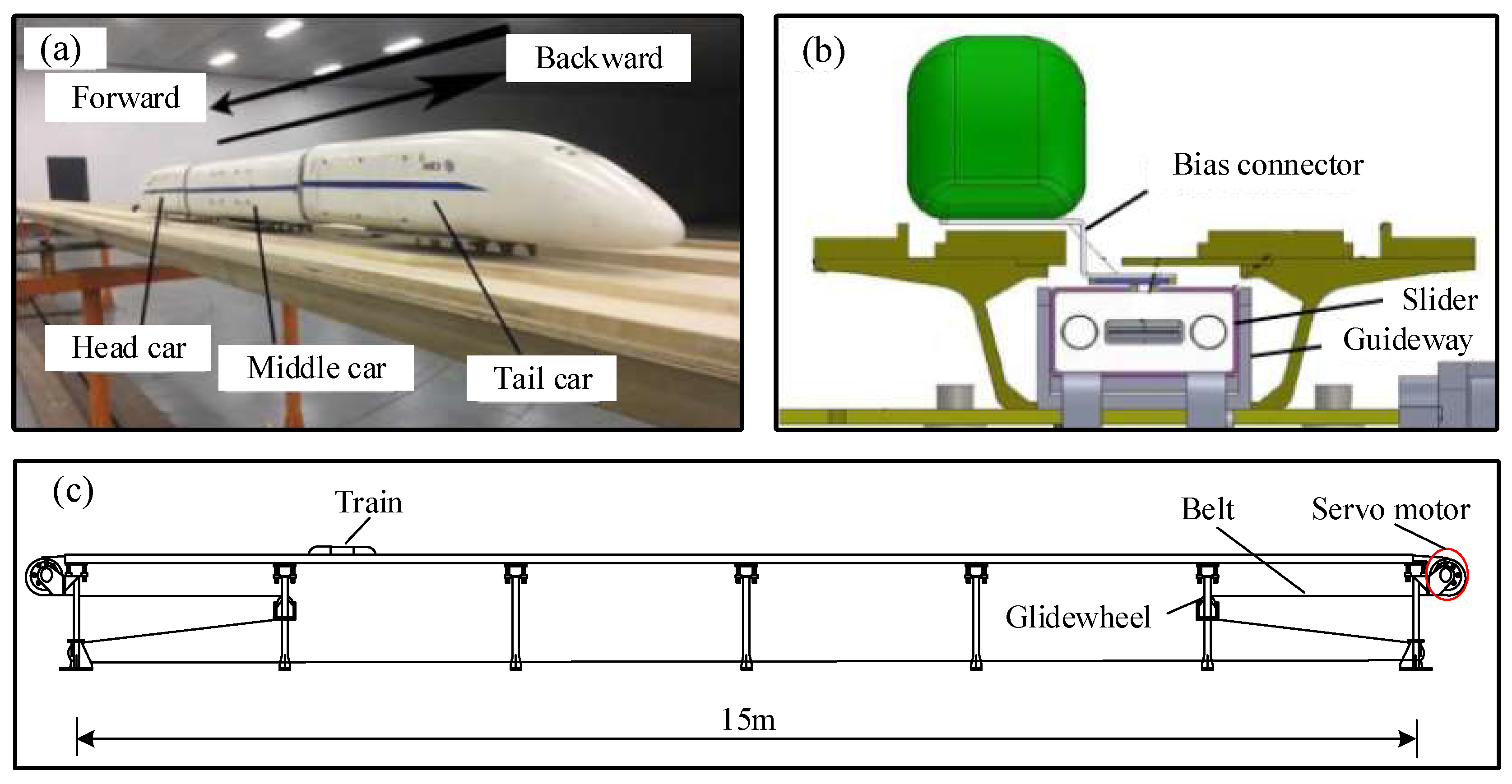


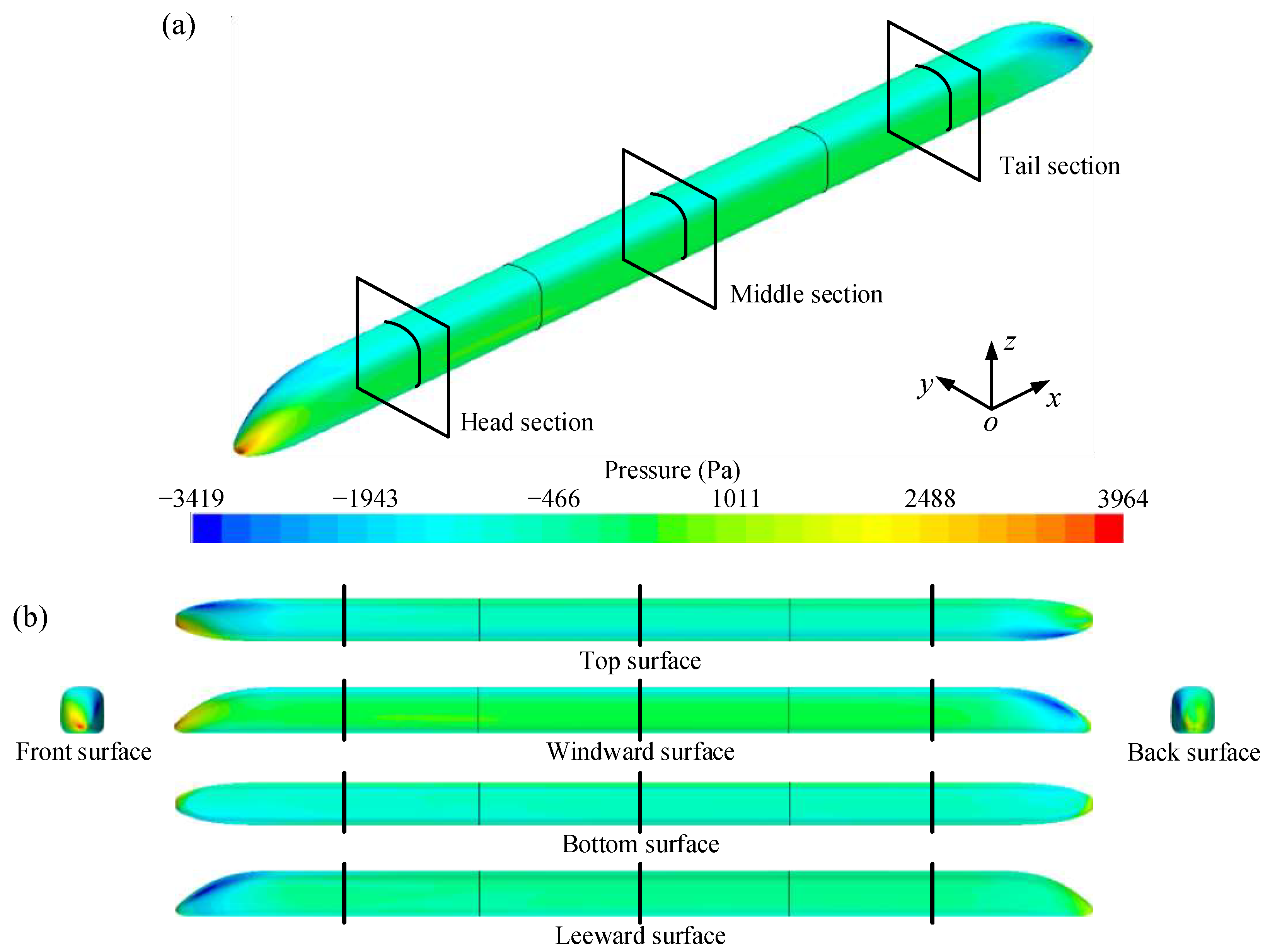









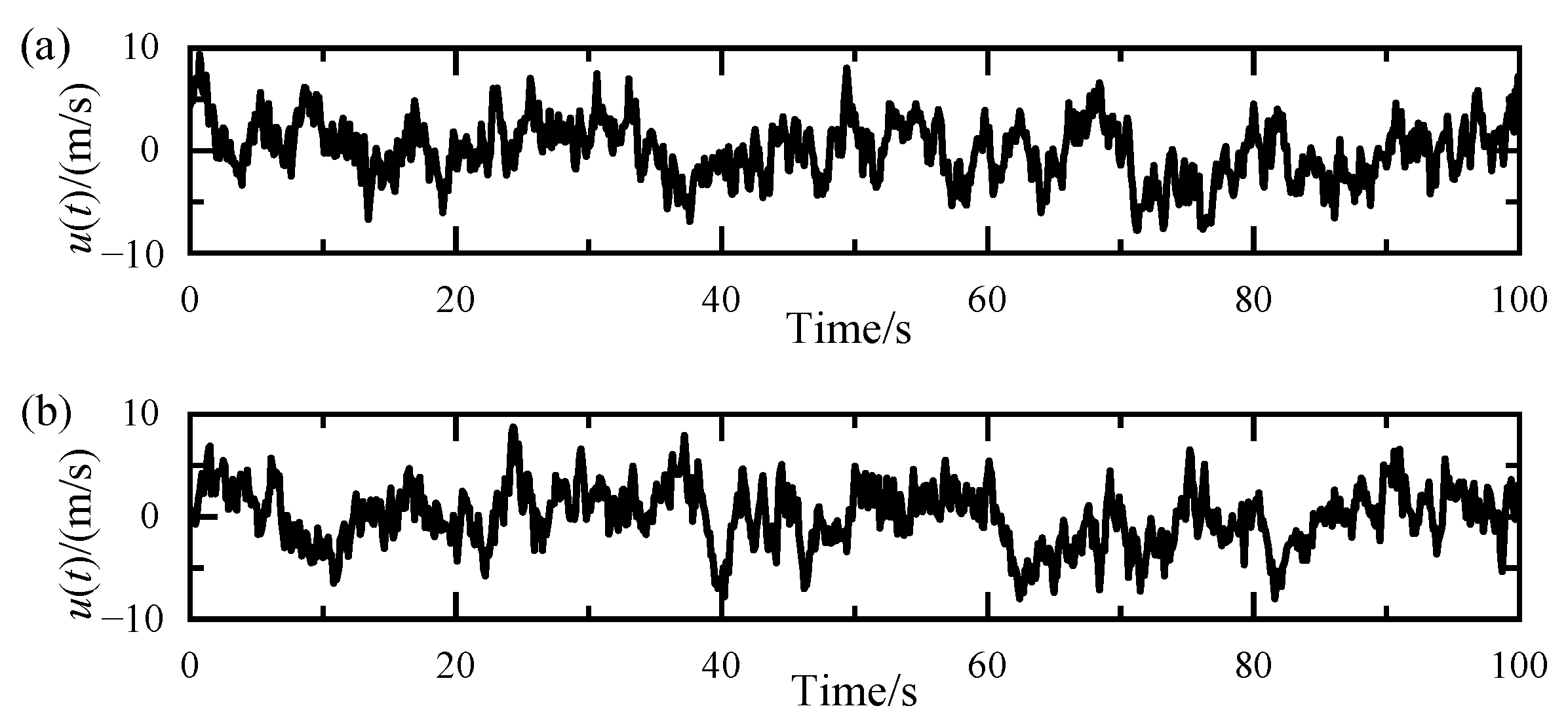



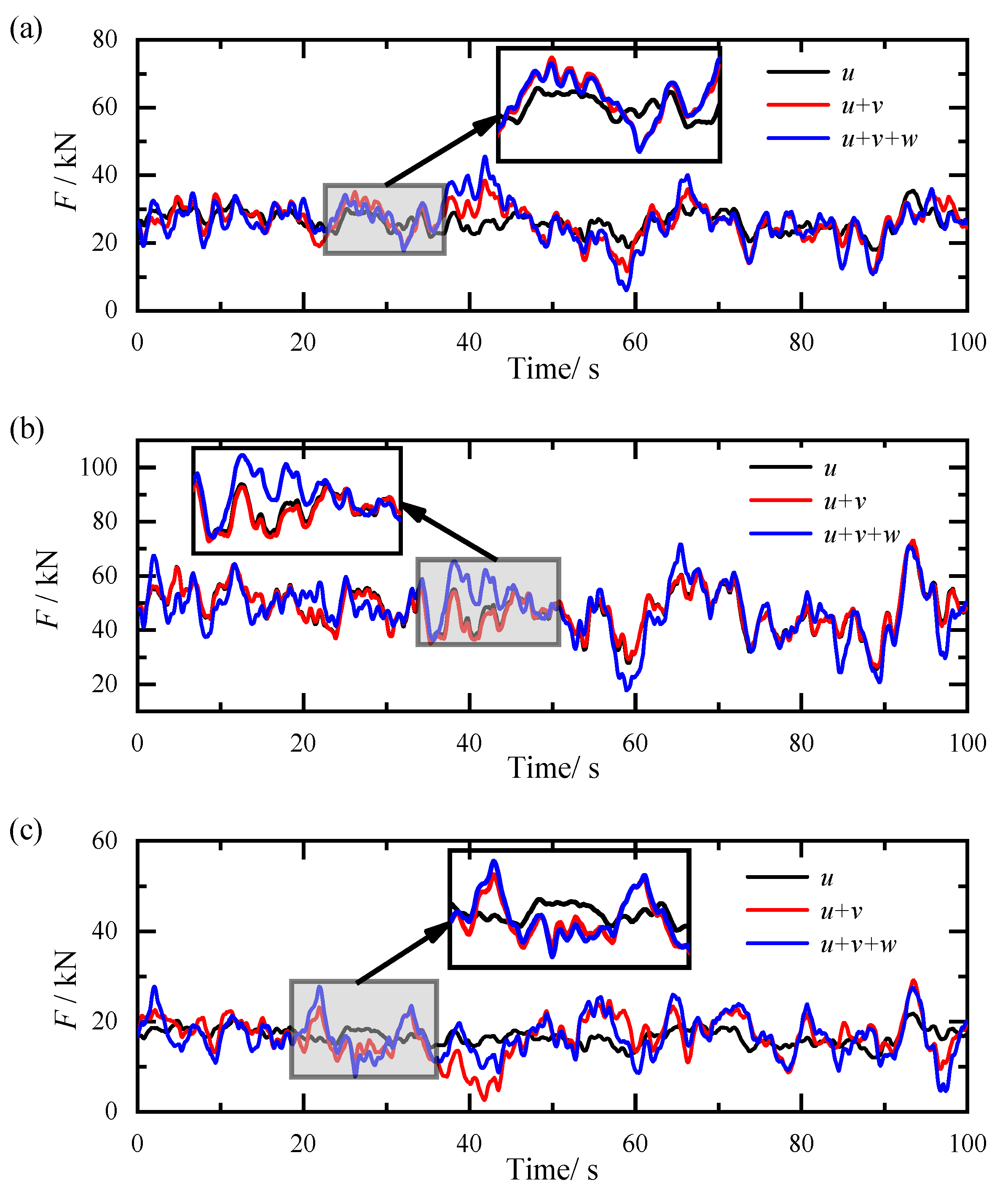

| Force Coefficient | Parameter | |||
|---|---|---|---|---|
| a | b | c | d | |
| CS | 0.5016 | −0.4643 | 0.0373 | 2.992 |
| CL | 0.2376 | −0.2382 | 0.0997 | 2.141 |
Publisher’s Note: MDPI stays neutral with regard to jurisdictional claims in published maps and institutional affiliations. |
© 2022 by the authors. Licensee MDPI, Basel, Switzerland. This article is an open access article distributed under the terms and conditions of the Creative Commons Attribution (CC BY) license (https://creativecommons.org/licenses/by/4.0/).
Share and Cite
Yao, Z.; Zhang, N.; Li, X.; Liu, Z. Simulation on Unsteady Crosswind Forces of a Moving Train in a Three-Dimensional Stochastic Wind Field. Appl. Sci. 2022, 12, 12183. https://doi.org/10.3390/app122312183
Yao Z, Zhang N, Li X, Liu Z. Simulation on Unsteady Crosswind Forces of a Moving Train in a Three-Dimensional Stochastic Wind Field. Applied Sciences. 2022; 12(23):12183. https://doi.org/10.3390/app122312183
Chicago/Turabian StyleYao, Zhiyong, Nan Zhang, Xiaoda Li, and Zongchao Liu. 2022. "Simulation on Unsteady Crosswind Forces of a Moving Train in a Three-Dimensional Stochastic Wind Field" Applied Sciences 12, no. 23: 12183. https://doi.org/10.3390/app122312183





